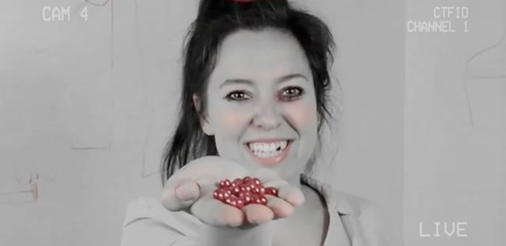Streams of innovation in an interactive ‘State vs. Natasha Banina’ – The Boston Globe

The space in question is occupied by Darya Denisova, who has emerged in the last few years as one of the most compelling actresses in the Boston area. Denisova’s mesmerizing portrayal of a 16-year-old Russian orphan on trial for attempted manslaughter helps to rescue “State vs. Natasha Banina’’ from the Lifetime-movie-style melodrama and bathos toward which it periodically veers.
We, the at-home audience, serve as the jury. Though Natasha defiantly flips us off at the beginning of the play, it becomes clear that she wants to tell her story. She wants to shock us, yes, but she might also want to enlist our empathy.
It is to us that defendant Natasha relates her tale of jumping out a third-floor orphanage window on a dare, then becoming romantically obsessed with a journalist who writes about the episode, training her sights on a girl whom she sees as a rival for the journalist. And it is we who vote on her guilt or innocence at the end.
In our quarantine moment, writers and directors everywhere are trying to figure out how to utilize streaming platforms to engage audiences, to present theater-without-theater. The most celebrated example so far is probably Richard Nelson’s new Apple Family play, “What Do We Need to Talk About?,’’ which premiered last month, presented by the Public Theater, with family members connecting over Zoom. But it was the format of “What Do We Need to Talk About?,’’ not the content, that offered the chief contrast with traditional theater.
“State vs. Natasha Banina,’’ however, incorporates the possibilities of film and video-game-style animation into its storytelling, while retaining the live-performance component of theater. (Future performances will also be live.) The production begins with a nod toward the kind of pre-show remarks common at theater productions, with a twist: A mask-wearing Golyak greets the audience with the words, “Welcome to our virtual courtroom.’’
The adapter-director employs a variety of cinematic techniques: closeups, medium shots, “Persona’’-like blurred imagery. Interstitial graphics abound, and Golyak even inserted a few deliberate glitches into the live feed on Sunday night. That jumpy visual and aural palette corresponds effectively with Natasha’s fragmented, discursive speaking style. Sometimes, though, the devices created a level of onscreen clutter that distracted our attention just when we wanted to focus on the play’s compellingly troubled protagonist.
Denisova has a history with the character of Natasha, and it shows in the velocity and depth of her performance. She played Natasha five years ago, in her first starring role, in a Golyak-directed production of “Natasha’s Dream,’’ the play by Yaroslava Pulinovich that Golyak has adapted into “State vs. Natasha Banina.’’
For the current production, Denisova has been made up so that Natasha has a broken tooth, and the actress does remarkable things with the character’s jagged smile, traversing a wide emotional palette from anger to desperation to a kind of pleading. Only rarely does Natasha’s smile convey anything like contentment or happiness.
There’s a physical intensity, too, to Denisova’s all-out portrayal of this lost girl. Her Natasha is a study in constant, jittery motion, as if she is trying to escape not just the white-walled room from which she speaks to us, but from the trap of her life. It’s telling that the journalist captures her heart by asking her a question no one before has ever asked: “What’s your dream, Natasha?’’ Among the last words we hear from Natasha, ostensibly about her rival but really encompassing a world that has treated her with such brutal indifference, are: “That’s not fair, to go around busting other people’s dreams.’’
Just last week Golyak and Denisova won Elliot Norton Awards from the Boston Theater Critics Association as outstanding director and outstanding actress for their work in “The Stone,” which also won for outstanding production.
In other words, they’re a very potent team, whether working onstage or — as with “State vs. Natasha Banina’’ — in that strange, still-developing space between stage and screen.
STATE VS. NATASHA BANINA
Adapted and directed by Igor Golyak. Based on “Natasha’s Dream,’’ by Yaroslava Pulinovich. Animation by Anton Iakhontov. Video by Igor Golyak. Music composed by Vadim Khrapatchev. Performed live on Sunday evenings from May 24-June 28 (no performance on May 31) on Zoom. Tickets free, with suggested donation. Reservations at www.arlekinplayers.com or 617-942-0022.
Don Aucoin can be reached at [email protected]. Follow him on Twitter @GlobeAucoin.
